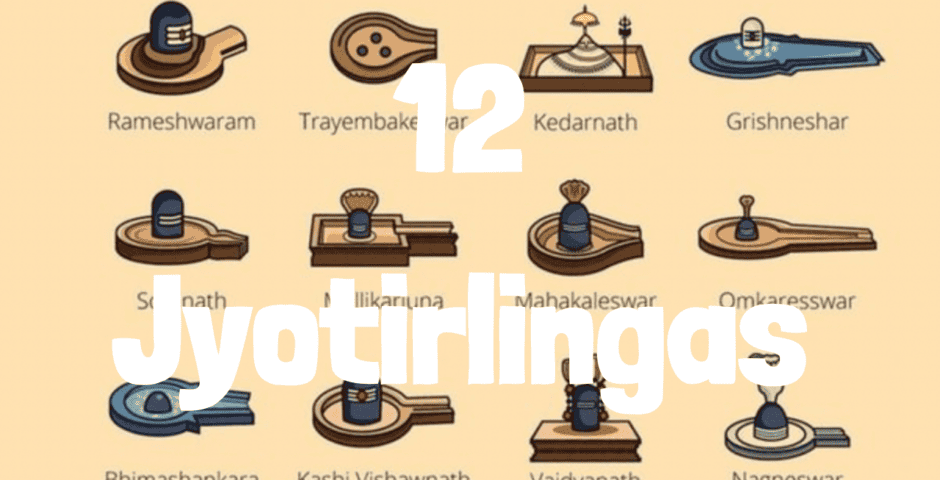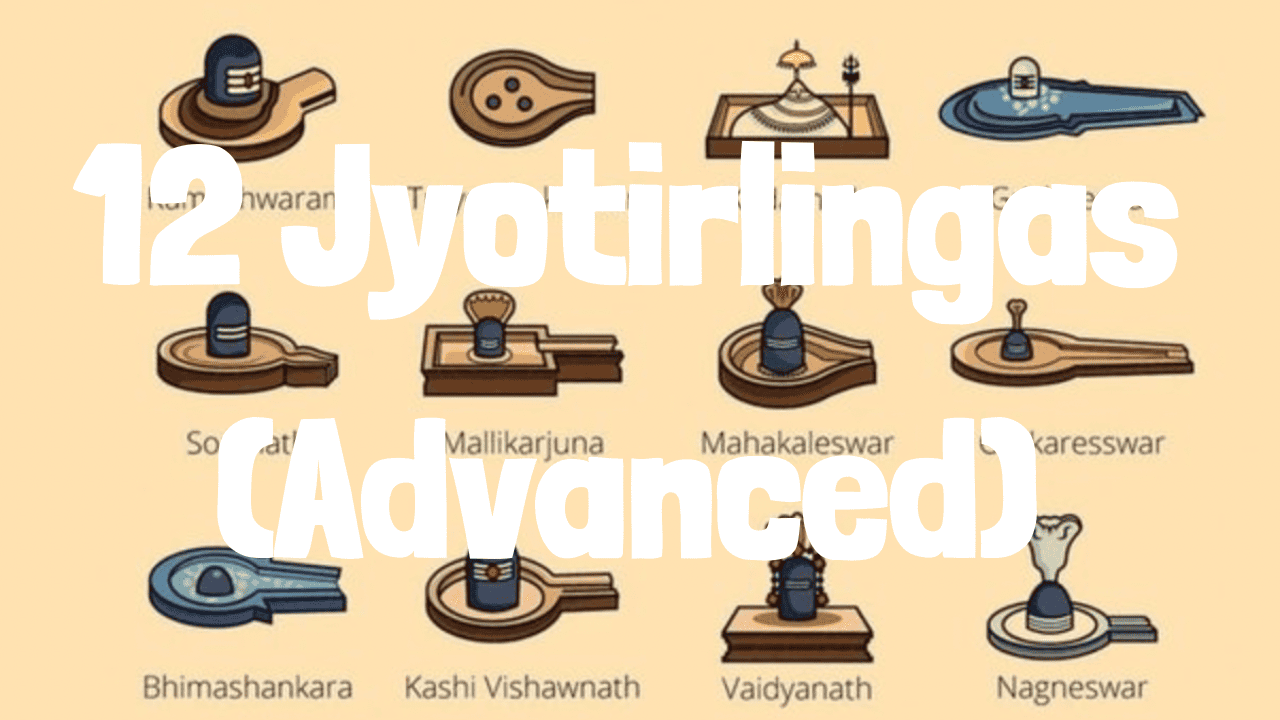
12 Jyotirlinga(s) Mantra Energised Series 108x
The 12 Jyotirlingas are sacred shrines dedicated to God Shiva, scattered across India.
A linga or lingam, is a phallic image of creation. The top represents the linga, which is shaped in the same way the physical universe exists, the base of the Linga, known as the Yoni, is the divine feminine energy, also known as shakti. Below that, which is the top part of the base of whole structure, represents the source of material existence, which is God Narayan + Goddess Latchmi, and the bottom part of the base represents the creator, known as Brahma.
As a whole, this phallic image represents the complete cycle of creation, from the source before creation, to creation, to sustenance of creation, to dissolution, and back to source.
A Jyotirlinga is a Linga, which has the complete divine presence of the divine masculine and divine feminine exisiting within it, at a heightened level of awareness. Meaning, that it is awakened, with the divine force ever-present in a living state.
Each Jyotirlinga holds deep spiritual significance and symbolises different aspects of God Shiva’s divine presence and power. Here’s a brief explanation of what each Jyotirlinga signifies:
- Somnath (Location: Gujarat. Mantra: Om Somanathaya Namah): Somnath Jyotirlinga symbolises the manifestation of God Shiva as “the Protector of the Moon.” It represents the eternal nature of Shiva’s energy and the triumph of light over darkness.
- Mallikarjuna (Location: Andhra Pradesh. Mantra: Om Mallikarjunaya Namah): Mallikarjuna Jyotirlinga represents the unity of God Shiva and Goddess Parvati. It signifies the divine harmony between masculine and feminine energies, and the importance of balance in spiritual practice.
- Mahakaleshwar (Location: Madhya Pradesh. Mantra: Om Mahakaleshwaraya Namah): Mahakaleshwar Jyotirlinga is associated with the aspect of God Shiva as “the God of Time or time itself” or “the Great God of Death or dissolution.” It symbolises the impermanence of life and the ultimate transcendence of time.
- Omkareshwar (Location: Madhya Pradesh. Mantra: Om Omkareshwaraya Namah): Omkareshwar Jyotirlinga is linked to the primordial sound “Aum” and represents the cosmic resonance of creation. It signifies the divine sound that underlies the universe and the power of sound in spiritual practice.
- Kedarnath (Location: Uttarakhand. Mantra: Om Kedarnathaya Namah): Kedarnath Jyotirlinga symbolises Lord Shiva’s role as “the Lord of Kedar Khand,” the region where it is situated. It signifies Shiva’s presence in the majestic Himalayas and the spiritual significance of the sacred land.
- Bhimashankar (Location: Maharashtra. Mantra: Om Bhimashankaraya Namah): Bhimashankar Jyotirlinga is associated with God Shiva’s manifestation as “the Supreme Self” or “the Cosmic Consciousness.” It represents the transcendental aspect of Shiva beyond the limitations of the physical world.
- Kashi Vishwanath (Location: Uttar Pradesh. Om Vishvanathaya Namah): Kashi Vishwanath Jyotirlinga symbolises God Shiva’s presence in the ancient city of Varanasi (Kashi), one of the holiest places in Sanatan Dharma. It signifies the eternal nature of Shiva’s divine presence in the cosmic order.
- Tryambakeshwar (Location: Maharashtra. Mantra: Om Tryambakeshwaraya Namah ): Tryambakeshwar Jyotirlinga is associated with the source of the sacred river Godavari. It represents the purifying and nourishing aspect of God Shiva’s energy and the importance of water in spiritual purification.
- Vaidyanath (Location: Jharkhand. Mantra: Om Vaidyanathaya Namah): Vaidyanath Jyotirlinga is revered as the “God of Physicians” and is associated with healing and well-being. It signifies the compassionate aspect of Lord Shiva as the divine healer who alleviates suffering.
- Nageshwar (Location: Gujarat. Mantra: Om Nageshwaraya Namah): Nageshwar Jyotirlinga is associated with God Shiva’s manifestation as “the Lord of the Nagas” or serpents. It symbolises the power of transformation and regeneration, as represented by the shedding of snake skins.
- Rameshwar (Location: Tamil Nadu. Mantra: Om Rameshwaraya Namah): Rameshwar Jyotirlinga is situated on the island of Rameswaram and is associated with God Shiva’s presence in the southernmost part of India. It signifies the importance of pilgrimage and spiritual devotion.
- Grishneshwar (Location: Maharashtra. Mantra: Om Ghrishneshwaraya Namah): Grishneshwar Jyotirlinga symbolises God Shiva’s role as “the Lord of Compassion” or “the Merciful Lord.” It represents the compassionate aspect of Shiva’s nature and the importance of love and empathy in spiritual practice.
Each of the 12 Jyotirlingas holds unique spiritual significance and serves as a sacred pilgrimage site for devotees seeking the blessings and grace of Lord Shiva.
Note. The locations are states on the Indian subcontinent.
Let’s go one step further.
In Vedic Astrology, there is planetary significance associated with the 12 Jyotirlingas, as each of these sacred shrines is believed to be associated with specific planetary alignments and energies.
Here’s a brief overview of the planetary significance related to each Jyotirlinga:
- Somnath (Gujarat): Somnath Jyotirlinga is associated with the Sun, representing vitality, power, and divine consciousness. Worship at Somnath is believed to enhance one’s solar energy and bring blessings of strength and enlightenment.
- Mallikarjuna (Andhra Pradesh): Mallikarjuna Jyotirlinga is associated with the Moon, symbolising emotional balance, intuition, and nurturing qualities. Devotees seek blessings for emotional stability and spiritual growth.
- Mahakaleshwar (Madhya Pradesh): Mahakaleshwar Jyotirlinga is associated with Saturn, representing discipline, karma, and spiritual maturity. Worship at Mahakaleshwar is believed to mitigate Saturn-related challenges and bring spiritual growth.
- Omkareshwar (Madhya Pradesh): Omkareshwar Jyotirlinga is associated with Mercury, symbolising intellect, communication, and adaptability. Worship at Omkareshwar is believed to enhance one’s intellectual faculties and communication skills.
- Kedarnath (Uttarakhand): Kedarnath Jyotirlinga is associated with Jupiter, representing wisdom, expansion, and divine grace. Devotees seek blessings for spiritual knowledge, prosperity, and auspiciousness.
- Bhimashankar (Maharashtra): Bhimashankar Jyotirlinga is associated with Mars, symbolising courage, strength, and determination. Worship at Bhimashankar is believed to enhance one’s martial qualities and provide protection from enemies.
- Kashi Vishwanath (Uttar Pradesh): Kashi Vishwanath Jyotirlinga is associated with Venus, representing love, beauty, and abundance. Devotees seek blessings for harmonious relationships, artistic pursuits, and material prosperity.
- Tryambakeshwar (Maharashtra): Tryambakeshwar Jyotirlinga is associated with Rahu (North Luna Node), representing illusions, desires, and karmic influences. Worship at Tryambakeshwar is believed to mitigate Rahu-related afflictions and bring clarity of mind.
- Vaidyanath (Jharkhand): Vaidyanath Jyotirlinga is associated with Ketu (South Luna Node), representing spirituality, detachment, and liberation. Devotees seek blessings for spiritual growth, healing, and liberation from worldly attachments.
- Nageshwar (Gujarat): Nageshwar Jyotirlinga is associated with Ketu as well, representing spirituality, mysticism, and enlightenment. Worship at Nageshwar is believed to enhance one’s spiritual practices and lead to inner transformation.
- Rameshwar (Tamil Nadu): Rameshwar Jyotirlinga is associated with the Sun, representing vitality, power, and divine consciousness. Devotees seek blessings for strength, vitality, and divine protection.
- Grishneshwar (Maharashtra): Grishneshwar Jyotirlinga is associated with the Moon, symbolising emotional balance, intuition, and nurturing qualities. Worship at Grishneshwar is believed to bring emotional stability and inner peace.
These planetary associations highlight the deeper cosmic connections and spiritual energies that are believed to be present at each of the 12 Jyotirlingas, making them significant pilgrimage sites for devotees seeking spiritual blessings and divine grace.
I’d like to clarify use of these protocols by believers of all faiths and religions. These energies are of the highest echelons of the universe / multiverse. Absolutely anyone and everyone can work with these energies without insulting the Gods that they believe in.
Why is this?
It Is because all of the religions on Earth, and the Gods of those various religions, all fall into the same universal hierarchy. We’re not saying this because we align with any particular faith, but because we have personal experience with all of the faiths from a Universal standpoint, and not something told to us by another human being.
Whether you’re a Christian, Muslim, Jewish, Hindu / Vendanta / Sanatani / Buddhist, etc, it does not matter. All of these Gods are part of the same Universal structure. In-fact, if I may introduce this little tidbit of information – all of the Gods of all these faiths, are already represented in the various religions.
The concept of heaven isn’t at Source level. It exists far lower in the Universal structure. Hence, some of the things we discuss, exists much higher than the levels most religions reveal on Earth. We’ll explain a little more about this in the comments section.
This protocol is the individual energy fields of the 12 mantras of the 12 Jyotirlingas. The Youtube version is the energy output equivalent of 108x of each of the 12 Jyotirlinga mantras, as written above.
The advanced version comes with two files. The first one is 1008x energy output equivalent of each of the 12 mantras. So, the file contains 12 massive blocks of energy that delivers 12,096x repetitions equivalent in energy. You can use the file for any one Jyotirlinga mantra, or you may utilise the energy of all 12 together.
The second file is a true blessing. It comes with the help and blessings of Goddess Kali, who guided us in being able to deliver this to you. The second advanced protocol delivers the personal blessings of each of the 12 Jyotirlingas, as if you had visited each of the Jyotirlingas sites yourself. You can now meditate with this protocol and receive the blessings of each of the Jyotilingas, or all 12 of them at the same time.
When you meditate with this second protocol, try doing so in a high vibrational state. So, try early in the morning after bathing, on an empty stomach. This would be ideal. Otherwise you may meditate with it at any time of day or night.
Note. Those of you new to our site and channel, these are not subliminals, so please play these protocols through speakers so as to expose your entire vibration to the energy fields.













